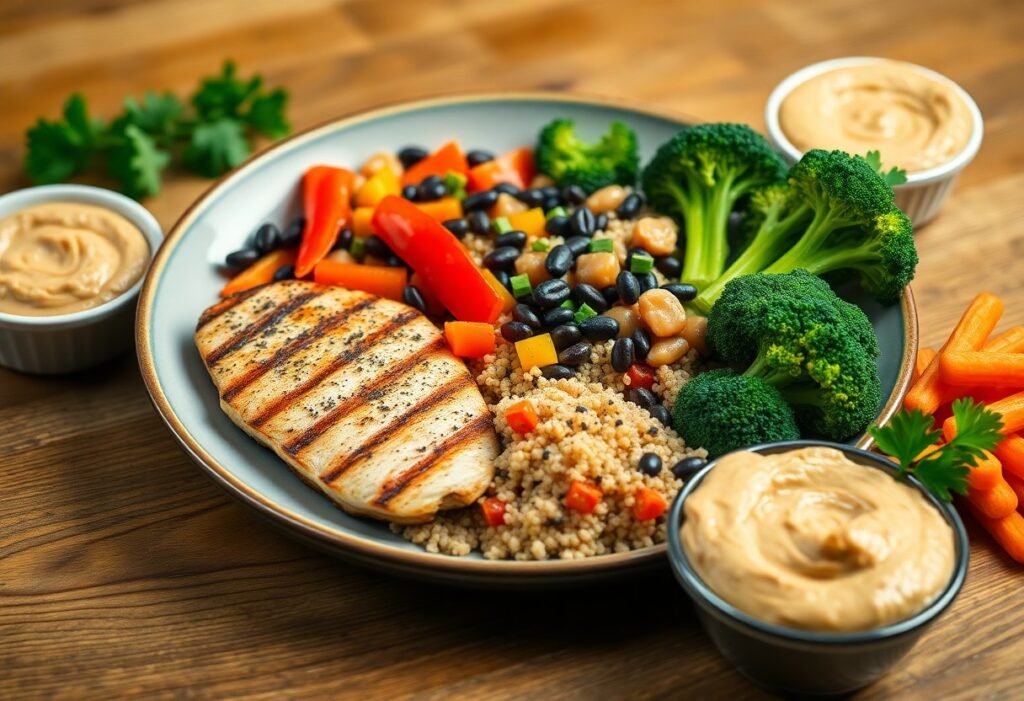Fitness is not just about shedding pounds; it’s about achieving sustainable weight loss that you can maintain for years to come. In 2025, focus on incorporating healthy habits into your daily routine, such as balanced nutrition and regular physical activity. You’ll want to avoid quick fixes and fad diets that can lead to weight regain and health issues. Instead, invest in lifestyle changes that promote your well-being, ensuring that the weight you lose stays off for good.

Key Takeaways:
- Focus on a balanced diet that incorporates whole foods, lean proteins, and healthy fats.
- Incorporate regular physical activity into your daily routine to enhance metabolism and support long-term weight management.
- Implement mindful eating practices to develop a healthier relationship with food and recognize hunger cues.
Understanding Sustainable Weight Loss
Defining Sustainable Weight Loss
Sustainable weight loss means achieving and maintaining a healthy weight through long-term lifestyle changes rather than quick fixes. This approach emphasizes steady progress, focusing on a balanced diet and regular exercise that fits your individual preferences and needs, allowing you to embrace a healthier lifestyle rather than just aiming for temporary results.
The Importance of Weight Maintenance
Weight maintenance is vital for long-term health and well-being. After you reach your desired weight, maintaining it prevents obesity-related conditions like heart disease and diabetes and boosts self-esteem. Consistency in your eating habits and exercise routine helps solidify the changes you’ve made, transforming them into lifelong behaviors.
Without effective weight maintenance, you risk regaining lost pounds, which can be disheartening and frustrating. Many individuals find that once they’ve achieved their target weight, they assume they can revert to previous eating habits. By implementing ongoing strategies such as regular check-ins, accountability, and support systems, you can maintain a healthy weight and reinforce your commitment to a sustainable lifestyle.
Key Factors Influencing Weight Loss Success
Several key factors influence your weight loss success, including your metabolism, dietary choices, and activity levels. Utilizing a balance of whole foods, understanding portion control, and engaging in regular physical activity will significantly impact your journey. Additionally, psychological elements, such as motivation and stress management, play vital roles in achieving and maintaining your weight loss goals.
- Metabolism
- Dietary choices
- Activity levels
- Psychological elements
By considering these influencing factors, you can create a personalized approach to weight loss that addresses your unique challenges and strengths. Maintaining a focus on these critical aspects will empower your journey, making weight management more achievable and satisfying. After evaluating these elements, you can identify the adjustments needed to optimize your strategies.
- Personalized approach
- Unique challenges
- Strengths
- Weight management

Setting Realistic Goals
How to Establish Achievable Weight Loss Goals
To set achievable weight loss goals, start by identifying what is both realistic and sustainable for you. Aim for a gradual weight loss of 1-2 pounds per week, as this can lead to more permanent changes. Break your larger goals into smaller milestones, focusing on specific behaviors, like exercising three times a week or making healthy meal choices. Utilize resources like 6 Exercises to Keep the Weight Off: A Guide to Maintaining … to support your journey.
Tips for Long-Term Weight Management
Long-term weight management requires a combination of behavioral changes and consistent effort. Focus on adopting a healthy lifestyle rather than just quick fixes. Establish a structured eating plan, monitor your progress, and adjust as necessary while allowing for occasional indulgences. Involve yourself in regular physical activity and consider joining support groups or fitness classes for motivation. The right mindset and community can significantly enhance your journey.
- Structured eating plan
- Regular physical activity
- Support groups
Explore various strategies for maintaining weight, such as keeping a food journal to track your intake or setting reminders for workouts. Engaging in social activities that promote active lifestyles can also be effective. The consistent effort in making healthier choices ultimately leads to success.
- Food journal
- Active lifestyles
- Consistent effort
The Role of Personal Accountability
Your commitment to accountability can significantly enhance your weight loss success. Sharing your goals with friends, family, or even a coach creates a supportive network that encourages you to stick to your plans. Regular check-ins and self-reporting can keep you on track, ensuring that you remain focused on your goals and recognize your achievements.
Consider finding an accountability partner or support group, as discussing your journey helps reinforce your resolve. Others can offer valuable insights and encouragement while providing a sense of community. The accountability you build with these relationships plays a crucial role in long-term success in managing your weight.
The Role of Nutrition
How to Create a Balanced Meal Plan
To create a balanced meal plan, focus on including a variety of food groups. Aim for whole grains, lean proteins, healthy fats, and an array of fruits and vegetables. Calculate your daily caloric intake needs, then allocate appropriate portions from each category. Tools like meal planning apps can simplify this process, helping you stay organized and accountable.
Tips for Mindful Eating
Mindful eating involves focusing your attention on the eating experience, which can aid in weight management. Take the time to savor each bite, chew thoroughly, and recognize your body’s hunger cues. This practice fosters a deeper connection with your food and may prevent overeating.
- Eliminate distractions during meals.
- Pay attention to flavor and texture.
- Eat slowly and without hurry.
- Practice gratitude for your meals.
Perceiving your meal as an experience allows you to enjoy food without excess. Not only does this enhance your appreciation, but it also helps maintain a healthy relationship with food, supporting long-term weight loss.
- Engage your senses while eating.
- Stop when you feel satisfied, not stuffed.
- Consider logging your meals to boost awareness.
- Reflect on the emotional context of your hunger.
Perceiving the emotional triggers behind eating can help you distinguish between true hunger and cravings. By addressing these feelings, you reinforce your ability to make informed decisions about when and what to eat.
Incorporating Whole Foods into Your Diet
Integrating whole foods into your diet means prioritizing unprocessed items such as fruits, vegetables, nuts, and legumes. These foods are nutrient-dense and can help you feel fuller longer, making weight maintenance more manageable. When grocery shopping, aim for the perimeter of the store, where whole foods are typically located.
Including an abundance of whole foods not only supports sustainable weight loss but also promotes overall health. Foods rich in fiber, like beans and leafy greens, aid digestion and keep you satisfied between meals. Adopting recipes based on these ingredients can help you explore new flavors while sticking to your health goals.

Incorporating Physical Activity
How to Develop an Effective Exercise Routine
To create an effective exercise routine, start by setting clear, achievable goals that align with your fitness level. Incorporate a mix of cardio, strength training, and flexibility exercises. Aim for at least 150 minutes of moderate-intensity aerobic activity per week, combined with muscle-strengthening activities on two or more days. Schedule workouts at convenient times and gradually increase intensity to avoid burnout. This personalized structure ensures you stay engaged and make consistent progress.
Tips for Staying Motivated to Exercise
To maintain motivation, set specific, measurable goals and track your progress regularly. Engage in activities you enjoy to make exercise feel less like a chore. Consider working out with a friend or joining a class for social support. Adding variety to your routine can also keep things fresh and exciting. Knowing your personal reasons for exercising will help you stay committed even when motivation dips.
- Set measurable goals
- Engage in enjoyable activities
- Seek social support
- Add variety
Staying motivated to exercise can sometimes be challenging, but establishing a routine that incorporates your interests can make a significant difference. For example, try joining community sports or engaging in group fitness classes to foster camaraderie. Keeping a workout journal helps reinforce your commitment by visualizing your progress. Knowing that every step contributes towards your overall health will fuel your determination.
- Establish a routine
- Engage in community sports
- Keep a workout journal
- Visualize your progress
The Benefits of Mixing Cardio and Strength Training
Mixing cardio and strength training offers numerous benefits, including improved cardiovascular health, enhanced muscle tone, and increased fat loss. Cardio activities boost endurance and elevate heart rate, while strength training helps build lean muscle mass. This combination not only boosts metabolism but also aids in preventing weight regain, providing a comprehensive approach to fitness that balances heart health and muscle development.
Incorporating both cardio and strength training can lead to greater health benefits, such as reduced risk of chronic diseases and improved overall well-being. Studies suggest that people who engage in a balanced routine are more likely to meet weight loss goals and maintain their weight long-term. Knowing this, adopting a versatile exercise strategy will not only enhance your physique but also promote lasting health advantages.
Behavioral Changes for Lasting Success
How to Identify Triggers for Unhealthy Eating
To pinpoint your triggers for unhealthy eating, keep a daily food journal that notes what you eat alongside your emotional state or activities at the time. Identify patterns by reviewing your entries; for instance, do you tend to snack mindlessly when stressed or bored? Recognizing these emotional cues can help you develop strategies to avoid or address them positively.
Tips for Developing Healthy Habits
Small changes can lead to significant results when developing healthy habits. Start by setting realistic goals, such as cooking more meals at home or increasing your vegetable intake. Replace unhealthy snacks with fruit or nuts and create a structured meal schedule to avoid impulsive eating. Establishing a routine around your meals and activities promotes consistency, thereby enhancing your overall success. Knowing your own patterns makes it easier to adjust your behaviors effectively.
- Set realistic goals.
- Replace unhealthy snacks with healthier options.
- Establish a structured meal schedule.
- Create a consistent routine.
Fostering healthy habits might also include seeking support, like joining a group with similar goals or working with a nutritionist. These connections provide accountability and shared experiences, further strengthening your commitment. Knowing this support system can enhance your motivation and keep you on the path toward sustainable weight loss.
- Join a supportive group.
- Work with a professional like a nutritionist.
- Share experiences for accountability.
The Power of Positive Reinforcement
Positive reinforcement is a powerful tool in maintaining your success. Reward yourself for reaching milestones, whether it’s treating yourself to a movie, buying new workout gear, or enjoying a spa day. This creates a positive relationship with your progress, making it easier to stay committed long-term.
Integrating positive reinforcement into your weight loss journey can prevent feelings of deprivation and promote motivation. Each time you achieve a goal, consider how to celebrate those moments without resorting to unhealthy choices. Using non-food rewards reinforces the connection between success and satisfaction.
Monitoring Progress
How to Track Your Weight Loss Journey
To effectively track your weight loss journey, utilize a journal or a mobile app to record your daily food intake, physical activity, and weekly weight changes. This comprehensive approach helps you identify trends, understand your eating patterns, and stay accountable. Weigh yourself consistently, ideally at the same time each week, to monitor progress accurately.
Tips for Adjusting Your Approach When Needed
When your weight loss plateaus or slows, reassess your current strategy. Consider adjusting your caloric intake or altering your exercise routine to maintain progress. Incorporating different workouts can reignite motivation and promote further fat loss. Additionally, minor tweaks in meal composition may help revive your results.
- Adjust caloric intake
- Alter exercise routines
- Incorporate new workouts
Knowing these strategies ensures you don’t become discouraged during your journey.
It’s vital to stay flexible and open to change when navigating your weight loss journey. If a specific method isn’t yielding results, don’t hesitate to experiment with new approaches. Your body may respond differently to varied types of exercise or meal plans, so be attentive to how you feel and adjust as necessary.
- Stay flexible
- Experiment with new methods
- Listen to your body
Knowing your body’s responses can guide you toward more effective strategies.
The Importance of Reflection and Adaptation
Regular reflection on your weight loss progress allows you to adjust your goals and strategies effectively. Adaptation is important; as you achieve your initial goals, it may be necessary to set new targets or modify your approach to maintain motivation and continued success.
Taking time to reflect on your journey can provide clarity and renewed focus. Consider what has worked well and what hasn’t, and use that evaluation to make informed decisions moving forward. Adapt your goals to align with your evolving lifestyle, ensuring that your weight loss journey remains sustainable and enjoyable.
To wrap up
Taking this into account, effective sustainable weight loss in 2025 requires a balanced approach that integrates healthy eating habits, regular physical activity, and mindful lifestyle changes. Focus on setting achievable goals, tracking your progress, and making gradual adjustments to your routine. It’s necessary to prioritize nutrient-dense foods and find enjoyable ways to stay active. By fostering a positive mindset and surrounding yourself with supportive individuals, you’ll enhance your ability to maintain your desired weight and promote long-term health and well-being.
FAQ
Q: What are the most effective strategies for sustainable weight loss in 2025?
A: Effective strategies include adopting a balanced diet rich in whole foods, establishing regular physical activity, setting realistic goals, practicing mindful eating, and prioritizing hydration.
Q: How can I maintain motivation throughout my weight loss journey?
A: Maintaining motivation can be achieved by tracking progress, celebrating small achievements, surrounding yourself with support, and continually educating yourself about health and nutrition.
Q: What role does portion control play in sustainable weight loss?
A: Portion control helps regulate calorie intake, promotes a balanced diet, and encourages awareness of hunger cues, making it easier to sustain weight loss over time.
Q: Are there specific diets that are considered more sustainable than others?
A: Diets focusing on whole foods, such as the Mediterranean diet or plant-based diets, have shown to be more sustainable due to their emphasis on nutritional variety and balanced eating patterns.
Q: How can I deal with weight loss plateaus effectively?
A: Dealing with weight loss plateaus can involve reassessing your calorie intake, changing workout routines, incorporating strength training, and ensuring adequate rest and recovery.









